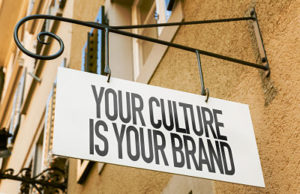|
|
 I love it when employees really adopt their company’s brand and make it their own. That’s one of the ways you know that your brand has really woven itself into the culture of your organization. But it rarely happens by accident. In any brand process, part of the process should be about helping your employees understand and internalize the brand.
I love it when employees really adopt their company’s brand and make it their own. That’s one of the ways you know that your brand has really woven itself into the culture of your organization. But it rarely happens by accident. In any brand process, part of the process should be about helping your employees understand and internalize the brand.
Then, you need to work with your team by job functions, helping each type of employee figure out how the brand influences their work. For example – if you’re a bank, how the tellers bring the brand to life will be very different from how the fraud department will live the brand.
Unfortunately, most companies take a shortcut that just makes their brand feel forced and artificial.
The first time I checked out at Walgreens and the clerk said “Be well,” I thought, well that’s cool – it fits with their whole brand and bravo to the clerk for making the brand her own.
After being in about five different Walgreens in several different states, I caught on. They had all been told to use “be well” as their farewell to customers. Suddenly the only thing “be well” communicated to me was a robotic script that completely lacked even an ounce of sincerity.
Probably not what Walgreens wants us to think about their “at the corner of happy and healthy” brand position.
That’s the problem with a lot of brands. You can’t just create a brand and slap it on your marketing materials. For a brand to actually mean something to your customers or your employees – it needs to be grounded in what you actually believe. It has to be built from your corporate values and be the sword you’re willing to fall on when there’s a conflict.
Your customers and employees have a pretty accurate BS meter and if your brand promise is superficial, they’re going to figure it out pretty quickly. Here are some things that trigger the meter.
Hyperbole: When you use loaded words that seem hyped and exaggerated, it immediately makes people suspicious. Use language that your audience can connect with and relate to, rather than words that feel artificial or impossible to achieve.
When it’s rote: Much like my experience in Walgreens, there’s a fine line between creating consistency in how your brand is communicated and it being robotic and stale. How often have you thought that a customer service rep was just reading from a script and really didn’t care if he had “met or exceeded all of your expectations today?”
One size fits all: If your brand position is so generic to your industry that your competitor could adopt and reasonably honor your brand – it’s not really a brand position at all. It’s simply a statement of what everyone in your industry should be delivering.
When it’s nothing more than marketing speak: A genuine brand isn’t just a marketing tool. It’s a divining rod that helps direct the entire company. I should feel your brand in my interactions with every single employee. But that requires commitment and investment on your part. It’s just spin if you sprinkle it in your marketing but not work to make it a part of your organization’s foundation.
When it works on the outside, but not inside: Your brand promise needs to be just as true internally as it is with your best customers. Remember – a good brand is your values in action. Values aren’t situational. You can’t expect your employees to behave according to your brand if you don’t in your dealings with them.
A brand is a promise of what it’s like to do business with you. Insincerity can kill your chances of even having a shot at delivering on that promise.
